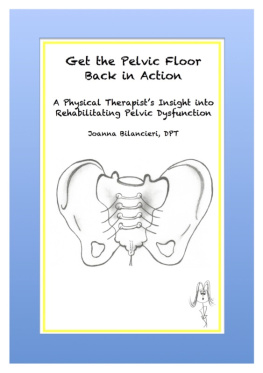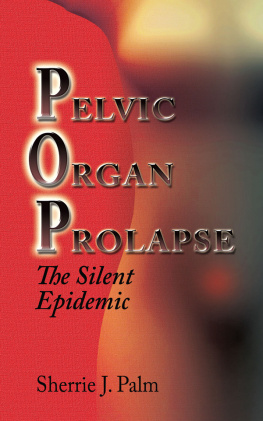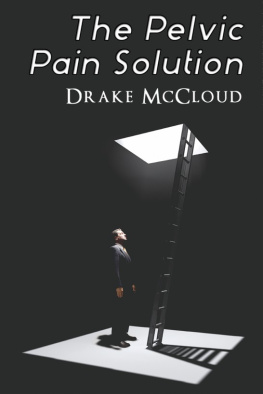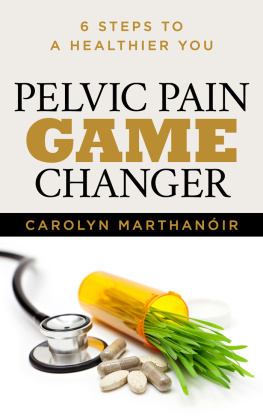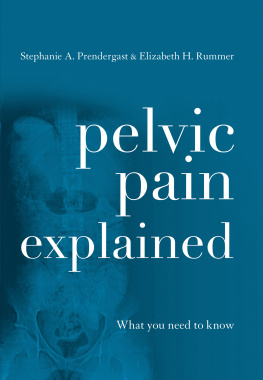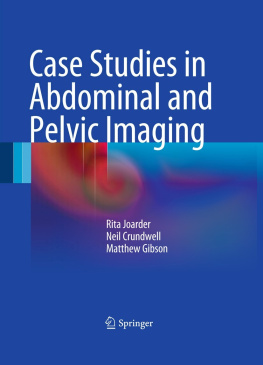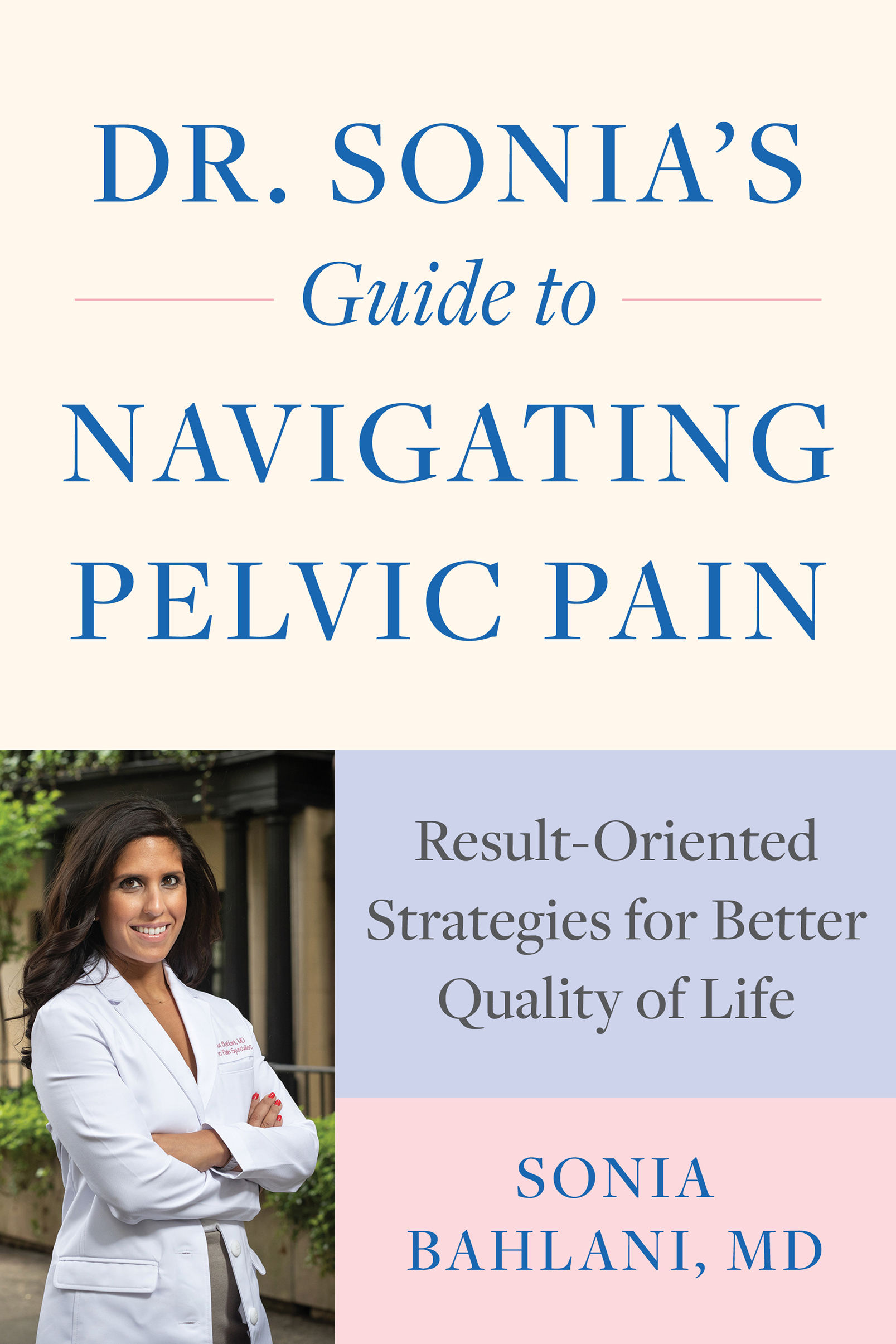Contents
Guide
Pagebreaks of the print version
D R. S ONIAS G UIDE TO N AVIGATING P ELVIC P AIN
ResultOrientedStrategies for Better Quality of Life
Sonia Bahlani, MD

For my mother, Pushpa Israni Bahlani, MD (November 29, 1945March 12, 2021), who inspired me to pursue my love for medicine, who encouraged me to follow my dreams, no matter where they took me, and who loved me unconditionallyand taught me to do the same.
Nothing would be possible without you.
CONTENTS
Clinical medicine is constantly changing. Some therapeutic methods I discuss in this book are off-label strategies, supported by anecdotal data and clinical experiences. And every patients needs are different.
This book is not meant to represent a comprehensive cohort of clinical care for every chronic pelvic pain patient. Its meant to empower you, the reader, to navigate your own care by helping you understand the known causes and treatment strategies currently available for pelvic pain. Ive included a Resources section of sources Ive relied on, and which you might find helpful as further reading (see ). My ultimate goal is to help those who are suffering find ways to reduce or ideally eliminate their suffering.
If youre dealing with pelvic pain, the first question you probably have is this: How do I feel better? I empathize with your desire to find relief as quickly as possible, but you and your health care providers first need to do your due diligence to uncover the root cause of your pain. My priority in my own practice is to treat the patient, not just their symptoms and this is the approach I advocate in this book. Treatment will help you feel better, but its only part of a bigger picture. Without first understanding whats causing your symptoms, you cant develop an informed and effective plan. Once your health care provider has investigated your pain and diagnosed your condition and its causes, they can then begin to create a holistic treatment plan, which I firmly believe should incorporate lifestyle consultation, wellness coaching, and actionable strategies and pain management techniques.
If you are reading this book, chances are that your pelvic pain has interfered with your life for long enough. That pain is your bodys way of telling you something is wrong. Are you ready to start listening?
When I became a physician, I guess you could say I went into the family business. I come from a family of physicians, dentists, and pharmacists, so I was immersed in the world of health care from a young age. I grew up watching doctors and nurses go about their day with my mom at the hospital. I spent countless hours with my dad at his office. And I loved it. I knew from early on that I, too, wanted to be a healer. I wanted to take care of people in their darkest moments. I wanted to live a life of purpose and have a direct impact on the lives of others.
And while Ive always wanted to be a doctor, I didnt necessarily grow up knowing or understanding the niche of pelvic pain. In fact, my path to where I am today was a long and winding one, with many forks in the road that forced me to choose a direction that would alter my original course. I arrived at one of my biggest turning points in 2012: I had just completed my residency in OB-GYN (obstetrics-gynecology) but felt unsure about my role in clinical medicine. Imagine training your entire life to do something and then thinking, Im not sure I want to do this.
I was questioning myself because I hadnt yet found my passion in womens health. Something was missing. As I began navigating the waters of womens health, I discovered an entire subset of patients who were often marginalized; they were searching for answers and being punted from doctor to doctor without adequate care. These patients suffered in silence for years without getting appropriate answers, and I knew I wanted to dedicate my life to helping them find relief. It was during this time that I decided to pursue my fellowship in urology, focusing my path in medicine on a patient-centered, rather than a problem-centered, approach. Thats when I finally found my place.
Understanding the nuances of urological and gynecological pelvic pain, an area of medicine that was essentially untapped, rekindled my passion for medicine. Watching my patients get better and get back to living their lives added fuel to that fire, too. And that, folks, is how I became the Pelvic Pain Doc!
I believe people have the power within themselves to manage and overcome their pain and to regain control of their lives. As I always tell my patients: Its my job to give you the tools to help you treat yourself, but its how you use those tools that really matters. My goal for this book is to provide you with information not only about helpful treatment strategies, but also to help you gain a well-rounded view of the multifactorial causes of pelvic pain. Armed with the facts, you can begin to take your healing into your own hands.
I also want you to remember that you are not alone in this. Pelvic pain does not discriminate: An estimated 15 percent of people (women and men alike) experience chronic pelvic pain at some point in their lives. In all likelihood, this number is drastically underreported due to social issues like stigmatization, and medical approaches that result in delayed diagnosis or misdiagnosis in many who suffer. This book is for all people, from all walks of life, of all ages and ethnicities, who have been affected by pelvic pain.
Fortunately, great strides have been made in the world of pelvic pain, thanks to clinicians who have pushed boundaries and challenged conventional thinking. Understanding and awareness of causes and treatment strategies for pelvic pain is not enoughknowledge of them must be translated into action to be truly valuable. With lifestyle modifications and active doctor-patient partnerships, this forward momentum will lead to actual lives changed.
And changing lives is what we are here to do. So lets get started!
P ELVIC PAIN IS DEFINED as any pain or discomfort, ranging from a sharp jab to a dull ache in the area below your belly button and between your hips that lasts six months or longer. The lower abdomen and pelvic region encompasses all the organs of your reproductive system and most of your digestive and urinary systems. Theres a lot happening in the pelvic areain your stomach, bowel, bladder, uterus, ovaries, prostate, testicles, penis, and moreso the source of pelvic pain can often be tough to identify. See for illustration.
It is important to consider that pelvic pain mechanisms may involve acute and chronic processes, both peripheral and central to the pelvic area, and may also have a significant emotional component. More often than not, there are multiple pain generators at play, which is what can make understanding and treating pelvic pain so complex.
I often hear my patients echo a common belief that a single action will relieve their pain. They might tell me, When I have my uterus/bladder/vagina/colon/prostate [this list goes on] removed my pain will be relieved. Unfortunately, the solution is not quite as simple as this.
I am reminded of the old Buddhist fable of the three blind men and the elephant. The men conceptualize what the elephant is like by touching it. The first man touched his trunk. It is a thick snake, he proclaimed. The second reached for his ear. It is a fan, he said. The third touched his leg. It is a tree trunk, he exclaimed. Of course, a whole elephant is none of these things. Their error is that of perception: They made dogmatic assumptions based on a limited perspective. The moral of the story is that none of the men were able to take a step back and to see the entire animal.


